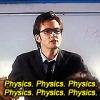
Wish me luck!
OK, that's one exam down! I think the multiple choice was a little rough (and by rough I mean there some questions that I completely guessed on because I had no clue) BUT I think the free response went better. There was a question on certain topic I hadn't studied (it was air resistance) so now I know what to study next time. Turns out I knew a lot more than I thought I did about mechanics! All in all, great learning experience!
Thanks for stopping by!
- Read more...
- 0 comments
- 986 views

